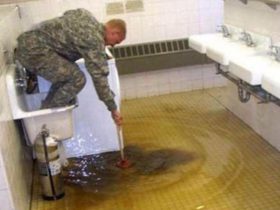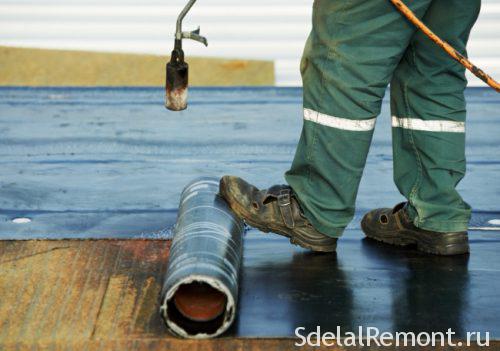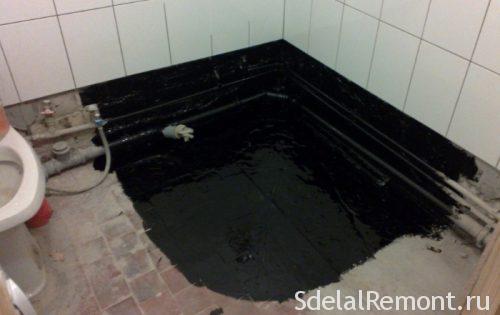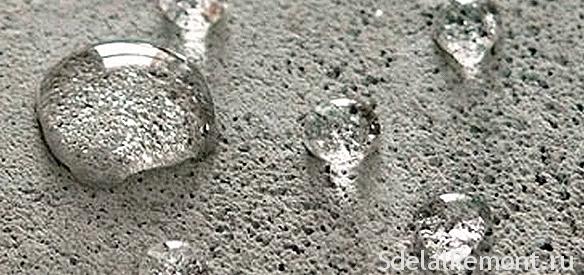An indispensable companion bathroom is wet. If you do not take measures to combat it, that soon it will penetrate into all the cracks and crevices and begin to spoil the overlapping materials, used in high-rise buildings. Ventilation is only partially helps to protect the room from moisture, but globally solve the problem only properly invested waterproofing in the bathroom.
What is the waterproofing?
The room is a bathroom always at risk to be filled with water. Such an unpleasant event may entail not only the deterioration of sanitary devices, finishing materials, contribute to the formation of mold, but the fly in the round sum neighbors, located downstairs. Bathroom just full of instruments with water and water pipes, which may fail. To protect yourself and your apartment from such risks, You need to consider waterproofing flat.
Of course, it does not save us from flooding, but it helps to prevent ingress of moisture or small amount of water through the floor. To protect themselves from damage ceiling upstairs neighbor, You can also equip a waterproofing and on it. Wall insulation is also important: Such protection will prevent mold and mildew, which it is very difficult to bring over time, as well as retain the decoration materials in their original form. The advantage of waterproofing walls may also be considered to prevent the emergence of slits, which are formed under prolonged exposure to moisture.
To equip the bathroom waterproofing is necessary during repairs, when finishing materials has not yet applied.
types of waterproofing
To date, there are several types of waterproofing materials: Rolling, obmazochnye, special waterproof plasters and paints, as well as chemical compositions based on rubber. The first two options are the most widely used.
- roll waterproofing. As the name implies, such insulating material is a specially coated roll, which will prevent the ingress of moisture on the floor. Roll waterproofing can be guided and okleechnoy. The first type of insulation for bathroom besides the protective material includes an adhesive layer, which was subsequently placed on the surface. This waterproofing involves the accuracy and lack of haste in, because the coating should initially lie flat, to continue to perform its function.

Roll waterproofing bitumen-based
Guided insulation roll type involves the use of a gas burner for a paving. At its core is fiberglass, and the inside - bitumen and protective film. When exposed to high temperatures, melted film, and bitumen becomes soft, whereby adhesion occurs to the surface coating. Advantage of this method is a kind of waterproof flooring carpet, which is sealed to the floor or walls, thus it is possible to be sure of the reliability of bonding. A disadvantage of such a method may be mentioned the use of special tools.
- surface waterproofing. This implies a special kind of weight, which is applied to the surface, then forms a moisture barrier layer, filling material all the cracks and micropores. In its composition obmazochnye mixture can have asphalt, cement or polymeric substance. Such waterproofing is perfect for baths with a non-standard form of premises, since it can be used even in the most remote places. The disadvantage of this method is the foul odor materials and poor resistance to temperature extremes.

- Waterproofing using plaster. Well-known manufacturers offer special plaster, based polymers contain, protect from moisture. The prepared solutions were applied to the surface first in the forward direction, and then in a perpendicular. To better protect professionals offer such plaster applied in several layers.

- Special impregnating compositions. Such mixtures contain bitumen composition, water glass or polymers. They are applied directly onto the prepared surface, impregnating and strengthening its.
Choose exactly the waterproofing, which is in all respects suitable for the bathroom space.
How to prepare the substrate for waterproofing
The bathroom has a special place, requiring higher. Even if the insulation will not pass on all surfaces: walls, floor and ceiling, According to the places you need to pay special attention:
- The floor and walls of the bottom. The most favorite places for moisture infiltration are these places, in particular about 20 see the wall up from the floor. paving waterproofing, do not miss this place and thoroughly treat it in order to avoid the appearance of mold and mildew;
- wall surface, surrounding each sanitary appliance. As known, near the toilet, sinks and bathroom, namely there, lie where water pipes, constantly accumulates condensate. There is also a considerable risk of an emergency with pipes, so do not neglect these places and they are also well waterproofed.
Of course, if resources permit and time, it is better to perform the waterproofing around the perimeter of the bathroom.
Despite, which method was chosen waterproofing, initially to prepare the surface for processing. This process takes place in several stages:
- Probably, Bathroom waterproofing occurs during the repair in the room, so the first step will be the complete removal of the old coating on the floor, walls and ceiling (If you want to);
- After removal of the coating, carefully scrape off even the smallest remnants of tile adhesive, or other substances, where old finishing material was secured;
- Clean the room from dirt and dust, bring all the garbage. If necessary - to wipe all surfaces with a damp cloth;
- Find all the cracks and crevices in the walls and floor and run their elimination, that is, to cover up with a solution;
- Process surface primer: for this ground should be diluted with water in the ratio of, which indicated on the packaging. Apply the first coat should be broad-brush bristle, then wait for drying. If required, procedure can be repeated;
- Next, pour the concrete floor. For this purpose there are special mixtures, which is diluted with water to a solid density, then poured on the floor and aligned;
- After drying screeds, should be applied to the primer layer.
The surface is now ready for further waterproofing.
The process of self-waterproofing bathroom
After surface preparation, should proceed to the application of waterproofing. As the main types of, common today, are rolled and lubricative, You need to consider the sequence of self-arrangement of the waterproofing in the bathroom.
Construction of roll waterproofing own hands
In order to pave their own okleechnuyu roll waterproofing, required: sharp knife construction, means for adhering waterproofing (not necessary, If the roll is already impregnated with adhesive base) and the actual roll of insulation material itself.
The sequence of works is as follows:
- The prepared surface is covered with a special bitumen impregnation, which provides better grip with the floor waterproofing;
- Pre-rolled material laid on the surface, cut into strips to length. When pruning is important to leave a margin on each side approximately 15 cm.;
- The cut pieces spread on the floor overlap, it does not leave gaps without material. Also, there should not be gaps at the joints between the wall and the floor. Places joints treated with a sealant, and the edges are rolled roller for better bonding with bitumen impregnation;
- If you decide to fill screed on top of the waterproofing, and not before, Then, at this stage, work needs to be done to complete the task;
- after drying,, surface can be coat with tiles or other surfacing materials.
- Do not forget, that in places of joining of waterproofing with pipes, must first close the tube with rubber seals.
Construction of surface waterproofing with their hands
When choosing a method of coating, Use only the waterproofing, which prevents the occurrence of fungus and mold. It is commercially available as ready-made mass, and dry powders, which should be diluted with water.
Step by step procedure works is as follows:
- Prepared surface clean from dust, dirt and debris and primed;
- There, where pipes should come in contact with insulation, wear special elastic bands;
- Joints in walls and floors, and angles sized special sealed ribbon;
- In the large-capacity bucket or diluted mixture with the help of the construction according to the instruction of the mixer;
- The mixture was applied to a surface and allowed to dry. Then the composition is applied once more and also dried.
- At the expiration of the complete drying, allowed to carry out finishing work.
For ease of application, better to use a roller or wide brush, and rubber gloves, to avoid getting material on hand.
Do not neglect the waterproofing in the bathroom, because this can be a simple process with high quality and inexpensive to make your own hands, and in the future bath will be protected from the damaging effects of moisture.












